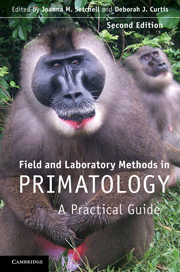Book contents
- Frontmatter
- Contents
- List of contributors
- Foreword by Robert D. Martin
- Introduction
- 1 An ethnoprimatological approach to interactions between human and non-human primates
- 2 Habituating primates: processes, techniques, variables and ethics
- 3 Habitat description and phenology
- 4 Geographical information systems and remote sensing
- 5 Monitoring local weather and climate
- 6 Survey and census methods: population distribution and density
- 7 Trapping primates
- 8 Handling, anaesthesia, health evaluation and biological sampling
- 9 Morphology, morphometrics and taxonomy
- 10 Marking and radio-tracking primates
- 11 Field experiments with non-human primates: a tutorial
- 12 Feeding ecology, frugivory and seed dispersal
- 13 Dietary analysis I: food physics
- 14 Dietary analysis II: food chemistry
- 15 Collecting arthropods and arthropod remains for primate studies
- 16 Recording primate vocalizations
- 17 Photography and video for field researchers
- 18 Chronobiological aspects of primate research
- 19 Thermoregulation and energetics
- 20 Field endocrinology: monitoring hormonal changes in free-ranging primates
- 21 Collection, storage and analysis of non-invasive genetic material in primate biology
- 22 Tips from the bush: an A–Z of suggestions for successful fieldwork
- Index
- References
8 - Handling, anaesthesia, health evaluation and biological sampling
Published online by Cambridge University Press: 05 June 2012
- Frontmatter
- Contents
- List of contributors
- Foreword by Robert D. Martin
- Introduction
- 1 An ethnoprimatological approach to interactions between human and non-human primates
- 2 Habituating primates: processes, techniques, variables and ethics
- 3 Habitat description and phenology
- 4 Geographical information systems and remote sensing
- 5 Monitoring local weather and climate
- 6 Survey and census methods: population distribution and density
- 7 Trapping primates
- 8 Handling, anaesthesia, health evaluation and biological sampling
- 9 Morphology, morphometrics and taxonomy
- 10 Marking and radio-tracking primates
- 11 Field experiments with non-human primates: a tutorial
- 12 Feeding ecology, frugivory and seed dispersal
- 13 Dietary analysis I: food physics
- 14 Dietary analysis II: food chemistry
- 15 Collecting arthropods and arthropod remains for primate studies
- 16 Recording primate vocalizations
- 17 Photography and video for field researchers
- 18 Chronobiological aspects of primate research
- 19 Thermoregulation and energetics
- 20 Field endocrinology: monitoring hormonal changes in free-ranging primates
- 21 Collection, storage and analysis of non-invasive genetic material in primate biology
- 22 Tips from the bush: an A–Z of suggestions for successful fieldwork
- Index
- References
Summary
INTRODUCTION
Primatologists capture wild primates for many reasons, including medical screening (Chapter 1), sampling for endocrinology, genetics (Chapter 21) and physiology (Chapter 19), or for marking and radiotelemetry (Chapter 10). Since capture and handling is always accompanied by the risk of injury or mortality, it is ethically important to maximize the information gathered during these procedures (Karesh et al., 1998). You should therefore collect biological samples every time wild primates are handled. New techniques are also emerging where biological and disease data can be obtained remotely (Jensen et al., 2009; Leendertz et al., 2004) and we encourage researchers to obtain data by using the least invasive methods available.
Infectious agents affect population dynamics, ecology, behaviour and reproductive success, and disease and health issues are thus widely recognized as important factors in wildlife conservation (Daszak et al., 2000; Deem et al., 2001). Primates deserve special attention for general health issues because of the potential for disease exchange between non-human primates and humans (zoonoses) (Chapter 1). The health status and diseases of free-living primates, the inter-relationships between diseases of wild primates and other biological parameters, and more generally the baseline biological parameters of primates under natural conditions, are rapidly growing areas of research. Moreover, emerging infectious diseases are a cause for concern in primates (Chapter 1; Leendertz et al., 2006) and primate researchers themselves have also been the origin of disease in wild primates (Kondgen et al., 2008).
- Type
- Chapter
- Information
- Field and Laboratory Methods in PrimatologyA Practical Guide, pp. 147 - 168Publisher: Cambridge University PressPrint publication year: 2011
References
- 9
- Cited by

